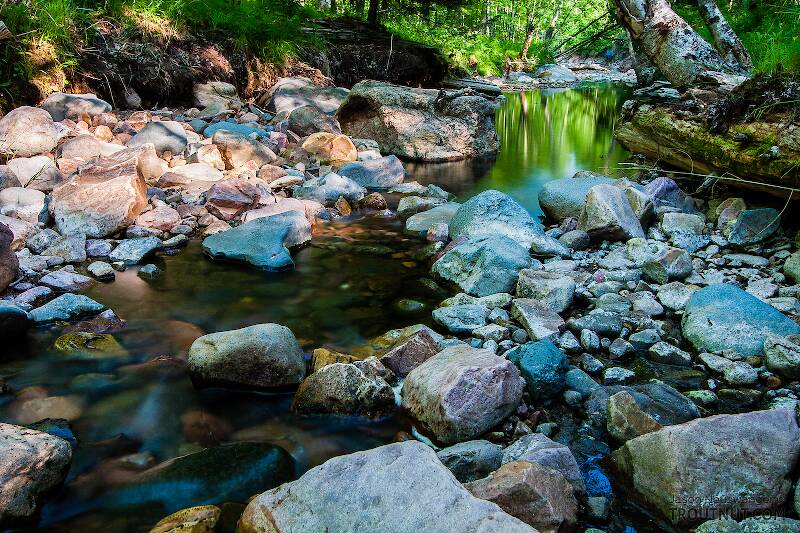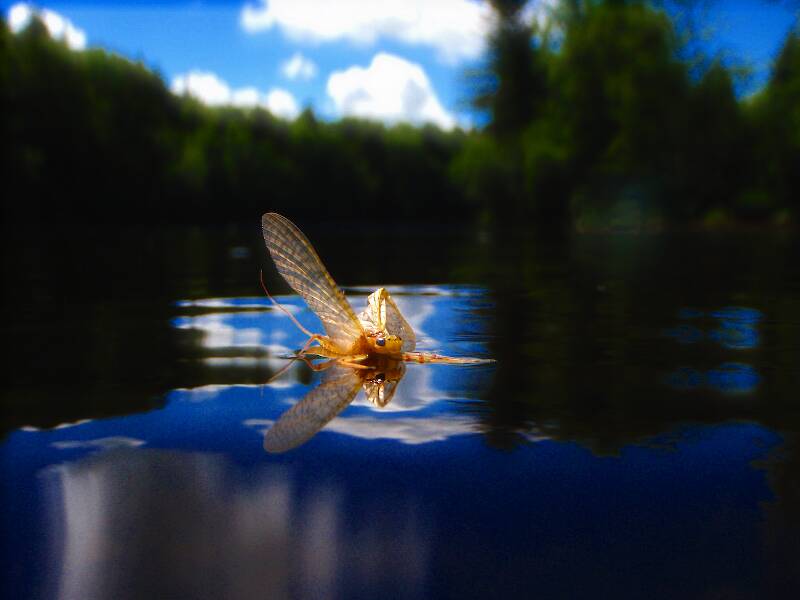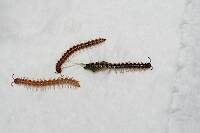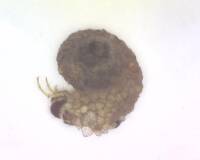
Blue-winged Olives
Baetis
Tiny Baetis mayflies are perhaps the most commonly encountered and imitated by anglers on all American trout streams due to their great abundance, widespread distribution, and trout-friendly emergence habits.
Featured on the forum

This one seems to lead to Couplet 35 of the Key to Genera of Perlodidae Nymphs and the genus Isoperla, but I'm skeptical that's correct based on the general look. I need to get it under the microscope to review several choices in the key, and it'll probably end up a different Perlodidae.

Troutnut is a project started in 2003 by salmonid ecologist Jason "Troutnut" Neuswanger to help anglers and
fly tyers unabashedly embrace the entomological side of the sport. Learn more about Troutnut or
support the project for an enhanced experience here.
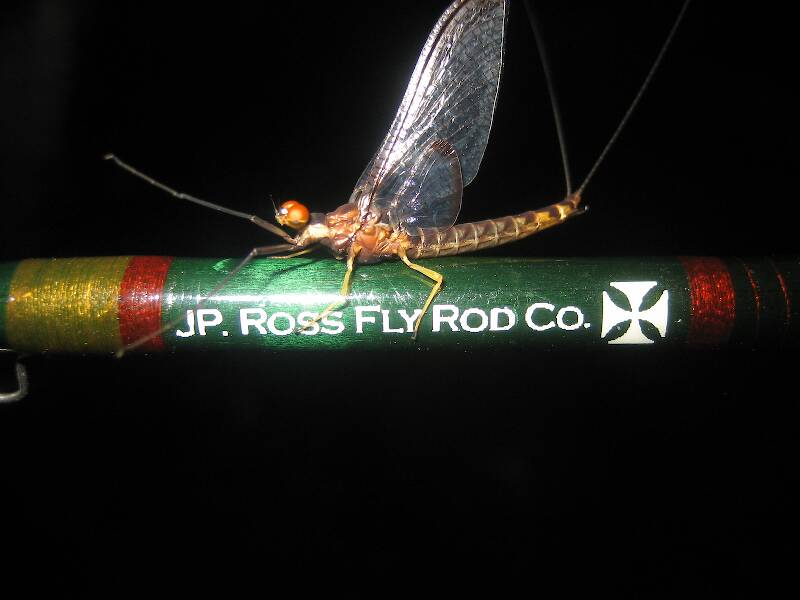
Al514 on Sep 22, 2007September 22nd, 2007, 3:32 pm EDT
So I got back out to that pond tonight to find a few of these guys flying around. It was 3 inches long from the front of its legs to the end of the tails. These guys are easy to catch!
Konchu on Sep 22, 2007September 22nd, 2007, 4:20 pm EDT
Four Hexagenia species have been reported from New York: H. atrocaudata, H. bilinieata, H. rigida & H. limbata.
*atrocaudata has the outer fourth of the hindwing dark colored
*bilineata has dark/light longitudinal banding
*rigida has bright yellow triangular marks on the abdomen
*most any other variations probably are the common limbata
From the photo, my guess is rigida. At first I thought limbata, but got a better look from a different angle to my screen. I've seen limbata on Midwestern ponds.
We'll see if Taxon proves me wrong.
*atrocaudata has the outer fourth of the hindwing dark colored
*bilineata has dark/light longitudinal banding
*rigida has bright yellow triangular marks on the abdomen
*most any other variations probably are the common limbata
From the photo, my guess is rigida. At first I thought limbata, but got a better look from a different angle to my screen. I've seen limbata on Midwestern ponds.
We'll see if Taxon proves me wrong.
Taxon on Sep 22, 2007September 22nd, 2007, 10:41 pm EDT
We'll see if Taxon proves me wrong.
Konchu-
My guess would be Hexagenia viridescens, one of the many species which were folded into H. limbata. Take a look at its description in TBOM, and see if you don't agree.
Al514-
That is a fantastic photo. My hat is off to you sir, or madam, as the case may be.
DGC on Sep 23, 2007September 23rd, 2007, 4:49 am EDT
Is the underside of the abdomen light olive?
If so we have had something very similar on one of our local (Chambersburg, PA) stocked streams in years past, though I don't know about this year because I've been targeting carp.
When one of those clumsy things hits you in the head you know it!
The fish responded to a modified compardun (add skinny rubber legs and leave a lump of exposed hair behind the extra heavy wing for floatation. About a size 10 2x long is what I used, though the natural is much larger than that as mentioned. Any number of other patterns probably would have worked as well.
If so we have had something very similar on one of our local (Chambersburg, PA) stocked streams in years past, though I don't know about this year because I've been targeting carp.
When one of those clumsy things hits you in the head you know it!
The fish responded to a modified compardun (add skinny rubber legs and leave a lump of exposed hair behind the extra heavy wing for floatation. About a size 10 2x long is what I used, though the natural is much larger than that as mentioned. Any number of other patterns probably would have worked as well.
Gene
Posts: 107
Posts: 107
Gene on Sep 23, 2007September 23rd, 2007, 5:49 pm EDT
Gentlemen:
(Please note I am writing this post for the novice fly anglers who sometimes frequent here not the entomologists). It may be fun to speculate on the species from the photo but once again coloration depends on the biogeochemistry of the stream, lake or pond especially in mayflies. We can accurately show whether Green Drakes come from streams like Kettle or Penns by the amount of blotching on the wings. Coloration in Hexagenia is similar and highly related to pH. Almost all mayflies can be used in this way to match them to the streams and bodies of water.
I have no problem with the speculation but unfortunately too many fly anglers and perhaps some entomologists give this method as correct. Years ago someone took one of my photos (of a sulfur) and by the photo alone some so called expert at one of the Univ. around D.C. proclaimed it to be another species.
The photo is excellent but without the genitalia all of you could be right, wrong or in between but it has nothing to do with what you see because the same species from another water of a different pH could have a different (lighter or darker pattern ) color pattern. It might be fun to have a bunch of different photos of the same species on here from lots of different streams to look at. Unfortunately, they probably would need to be photographed by the same person under the exact same lighting conditions.
So if you are a novice fly angler...this is just for fun about naming species by color and it's a nice game to play. Just don't take it too seriously. Dr. Philip Lewis (EPA Cincinnati?..most likely retired by now) who worked on Stenonema and Stenacron years ago was adamant about the misuse of color by fly anglers in referring to species and even some in the aquatic entomology community.
Remember for the most accurate species ID (without DNA that is) we all know this: VIRGIN MALES...I MEAN THE MAYFLIES OF COURSE not the identifier (this note is for the fly anglers not the entomologists on this board). I once wrote that in a little article in someone's newsletter years ago and evidently I didn't make it clear that I was talking about the mayflies. Some guy's wife read it and almost laughed herself to death because she thought I was talking about the entomologist. She couldn't figure out why the guy looking at the insects...well you get it. It seems like I ran into the same problem in D.C. once when I was speaking years ago at a TU meeting and there were some women who had just gotten into fly fishing. Someone asked a question about the proper way to identify and of course I gave them the spill!
These ladies started laughing in the back and I had to rephrase and explain it again. Well that actually made it worst when one of the ladies asked, "What happens to their... you know thing when they do it!" In my infinite wisdom I said, "Well it sometimes gets damaged!" I should have quit while I was ahead.
Anyway it as Walton said, "Because no man is born artist..no man is born an angler or something like that as the lady said in the back of the room.....
tight lines and autumn hatches...
gene macri
www.flyfisher.com
(Please note I am writing this post for the novice fly anglers who sometimes frequent here not the entomologists). It may be fun to speculate on the species from the photo but once again coloration depends on the biogeochemistry of the stream, lake or pond especially in mayflies. We can accurately show whether Green Drakes come from streams like Kettle or Penns by the amount of blotching on the wings. Coloration in Hexagenia is similar and highly related to pH. Almost all mayflies can be used in this way to match them to the streams and bodies of water.
I have no problem with the speculation but unfortunately too many fly anglers and perhaps some entomologists give this method as correct. Years ago someone took one of my photos (of a sulfur) and by the photo alone some so called expert at one of the Univ. around D.C. proclaimed it to be another species.
The photo is excellent but without the genitalia all of you could be right, wrong or in between but it has nothing to do with what you see because the same species from another water of a different pH could have a different (lighter or darker pattern ) color pattern. It might be fun to have a bunch of different photos of the same species on here from lots of different streams to look at. Unfortunately, they probably would need to be photographed by the same person under the exact same lighting conditions.
So if you are a novice fly angler...this is just for fun about naming species by color and it's a nice game to play. Just don't take it too seriously. Dr. Philip Lewis (EPA Cincinnati?..most likely retired by now) who worked on Stenonema and Stenacron years ago was adamant about the misuse of color by fly anglers in referring to species and even some in the aquatic entomology community.
Remember for the most accurate species ID (without DNA that is) we all know this: VIRGIN MALES...I MEAN THE MAYFLIES OF COURSE not the identifier (this note is for the fly anglers not the entomologists on this board). I once wrote that in a little article in someone's newsletter years ago and evidently I didn't make it clear that I was talking about the mayflies. Some guy's wife read it and almost laughed herself to death because she thought I was talking about the entomologist. She couldn't figure out why the guy looking at the insects...well you get it. It seems like I ran into the same problem in D.C. once when I was speaking years ago at a TU meeting and there were some women who had just gotten into fly fishing. Someone asked a question about the proper way to identify and of course I gave them the spill!
These ladies started laughing in the back and I had to rephrase and explain it again. Well that actually made it worst when one of the ladies asked, "What happens to their... you know thing when they do it!" In my infinite wisdom I said, "Well it sometimes gets damaged!" I should have quit while I was ahead.
Anyway it as Walton said, "Because no man is born artist..no man is born an angler or something like that as the lady said in the back of the room.....
tight lines and autumn hatches...
gene macri
www.flyfisher.com
Taxon on Sep 23, 2007September 23rd, 2007, 8:44 pm EDT
Okay Gene, let me make sure I've got this straight.
Novice fly anglers should only identify virgin males, due to their likelihood of having undamaged thingies. However, this is not an important consideration for entomologists, as they enjoy the luxury of DNA testing, which compensates, not only for their inability to ignore color variation, but also for their damaged thingies.
Novice fly anglers should only identify virgin males, due to their likelihood of having undamaged thingies. However, this is not an important consideration for entomologists, as they enjoy the luxury of DNA testing, which compensates, not only for their inability to ignore color variation, but also for their damaged thingies.
Gene
Posts: 107
Posts: 107
Gene on Sep 24, 2007September 24th, 2007, 5:42 am EDT
Taxon:
Well not quite. I just want novices to realize that for true species identification...we need the undamaged thingies.....Entomologists already know they need the thingies...preferably undamaged unless of course they don't need the thingies if they have good DNA.
Now I'm sure that clears up the whole thingie manifestations congromerlate.
tight lines and undamage thingies for all
gene
www.eugenemacri.com
Well not quite. I just want novices to realize that for true species identification...we need the undamaged thingies.....Entomologists already know they need the thingies...preferably undamaged unless of course they don't need the thingies if they have good DNA.
Now I'm sure that clears up the whole thingie manifestations congromerlate.
tight lines and undamage thingies for all
gene
www.eugenemacri.com
Konchu on Sep 24, 2007September 24th, 2007, 9:54 am EDT
...on the next episode of Montel...
Quick Reply
Related Discussions
Topic
Replies
Last Reply
1
Aug 1, 2008
by Troutnut
by Troutnut
1
Oct 24, 2011
by Agtabrentwi
by Agtabrentwi
1
Mar 29, 2009
by Taxon
by Taxon

